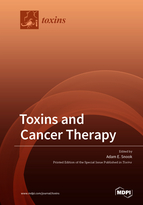Toxins and Cancer Therapy
A special issue of Toxins (ISSN 2072-6651).
Deadline for manuscript submissions: closed (31 January 2020) | Viewed by 27060
Special Issue Editor
Interests: guanylyl cyclases; intestinal epithelial cell biology; GI malignancies; colorectal cancer; targeted therapeutics; cancer mucosal antigens; cancer vaccines; immune tolerance; adoptive cell therapy
Special Issues, Collections and Topics in MDPI journals
Special Issue Information
Cancer is the second leading cause of death globally and is expected to become an increasing health, social, and economic burden over the coming decades as industrial lifestyles become more prevalent around the world. Approaches to cancer therapy have relied primarily on the selective toxicity of anticancer drugs. Indeed, more than 100 years ago, William Coley, a surgeon at Memorial Hospital in New York, was injecting patients with live bacteria and bacterial products to treat their cancers, often producing remarkable results, especially when treating sarcomas. “Coley’s Toxins” in their original form are no longer used, but the principles Coley began to uncover in the 1890s have evolved into our modern armamentarium for the treatment of cancer. The immunological mechanisms exploited by Coley and uncovered by a century of basic and clinical research have led to the development of remarkable new cancer immunotherapies—between 2015–2018 alone, 46 new cancer immunotherapy indications were approved by the US FDA. Moreover, while Coley’s treatments were often toxic, modern therapies selectively deliver toxic agents to tumors, using targeted radiotherapy, immunotoxins, and nanodelivery systems. Modern approaches even include bacterial enterotoxins, bacteria, and oncolytic viruses to prevent or treat cancer. Together, these therapies are transforming clinical cancer care, but their continued development and new discoveries are needed to ultimately address our growing need for safe and effective cancer therapies over the coming decades.
Keywords
- Cancer
- Immunotoxins
- Immunotherapy
- Radiotherapy
- Nanodelivery
- Bacteria
- Oncolytic viruses
- Enterotoxin







